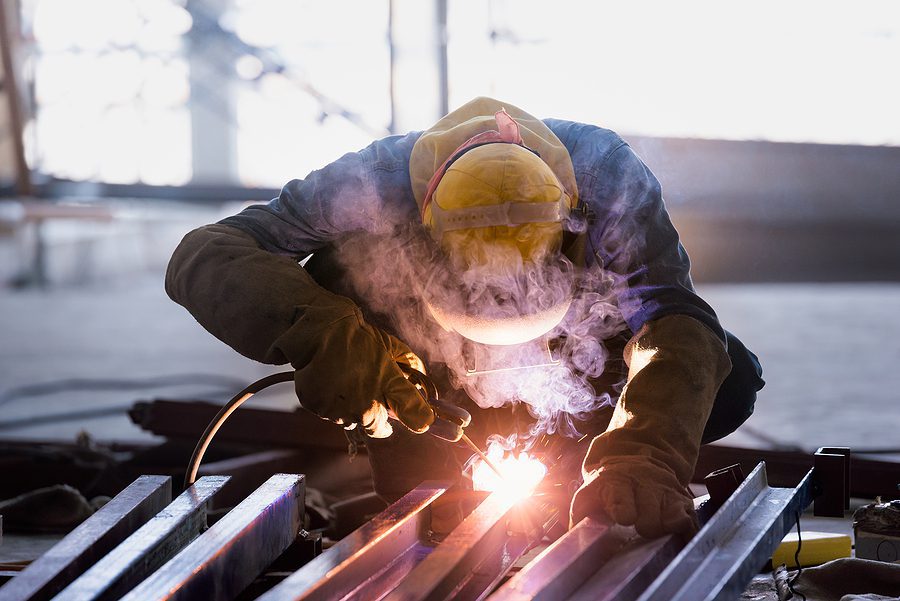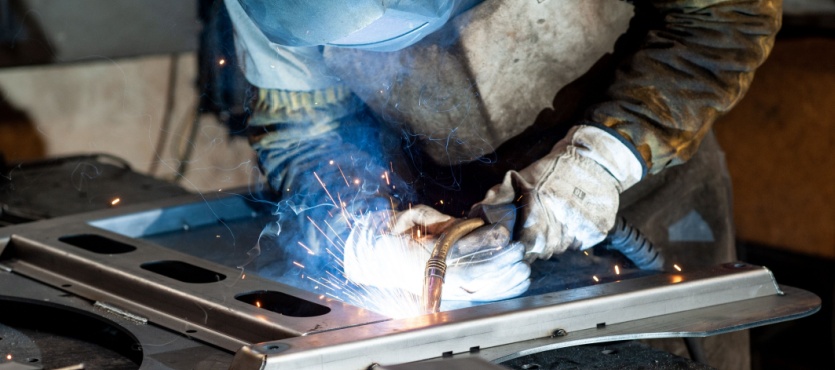Ways to minimize distortion in Montana Mobile Welding and Repair Welding projects
Everything about Welding: Secret Insights Into Techniques and Finest Practices for Success
Welding encompasses a range of techniques, each matched for specific products and applications. Recognizing these techniques, such as GMAW, SMAW, and TIG, is crucial for attaining excellent results. Moreover, the best equipment and safety techniques can not be forgotten. As prep work and troubleshooting play crucial roles in the welding procedure, grasping these aspects can significantly improve the quality of the last item. What are the crucial aspects that ensure a successful weld?
Recognizing Various Welding Techniques
Welding methods incorporate a range of techniques, each matched to certain applications and materials. Amongst one of the most usual strategies are Gas Metal Arc Welding (GMAW), Secured Metal Arc Welding (SMAW), and Tungsten Inert Gas Welding (TIG) GMAW, additionally called MIG welding, is preferred for its speed and convenience, making it optimal for slim materials. SMAW, or stick welding, is favored for its simpleness and performance in outdoor atmospheres, specifically with thicker metals. TIG welding provides accuracy and control, making it appropriate for complex job and non-ferrous steels (Montana Mobile Welding and Repair Fabrication). Each method has its special advantages and factors to consider, permitting welders to select the ideal method based upon the task's demands, product kind, and preferred end results. Recognizing these strategies is necessary for effective welding
Important Welding Tools and Devices
While different welding strategies need details abilities, the ideal equipment and devices are similarly vital for achieving high quality results. Necessary welding devices includes welding devices, which differ depending upon the strategy-- such as MIG, TIG, or stick welding. Protective gear, consisting of aprons, handwear covers, and safety helmets, guarantees safety and security and convenience throughout the procedure. Furthermore, fixtures and clamps help safeguard products in place, guaranteeing accuracy in welds. Consumables like welding rods, cord, and shielding gas are also important elements that affect the quality of the weld. Devices such as cutters and mills help with surface area prep work and post-weld ending up, contributing to a specialist end result. Investing in premium equipment eventually enhances the performance and efficiency of welding tasks.
Safety Practices in Welding
Correct safety and security techniques are vital in the welding industry to secure workers from prospective hazards. Welders must use suitable individual protective tools (PPE), including helmets with correct shading, gloves, and flame-resistant clothes. Sufficient ventilation is crucial to lower direct exposure to damaging fumes and gases generated during the welding process. Additionally, employees ought to be trained in the appropriate handling of welding tools to avoid crashes. Fire precaution, such as keeping flammable products away from the welding location and having fire extinguishers conveniently available, are needed. Normal inspections of tools and offices can help identify potential threats prior to they lead to crashes. By adhering to these security techniques, welders can create a more secure working environment and decrease risks connected with their profession.
Readying Materials for Welding
Preparing products for welding is a vital step that substantially influences the high quality and honesty of the last product (Welding). Correct prep work entails cleansing the surface areas to get rid of contaminants such as dirt, oil, and rust, which can compromise the weld. Strategies such as grinding, sanding, or utilizing solvents are frequently used to accomplish a clean surface. In addition, guaranteeing that the materials mesh comfortably is essential; voids can cause weak welds. It's likewise essential to take right into account the positioning and positioning of the elements, as this will certainly affect the convenience of welding and the last outcome. Ultimately, choosing the appropriate filler product and guaranteeing compatibility with the base steels is essential for accomplishing solid, long lasting welds
Tips for Achieving High-Quality Welds
Achieving top quality welds needs focus to detail and adherence to best methods throughout the welding procedure. Correct joint prep work is essential, making certain surface areas are tidy and totally free from impurities. Selecting the suitable filler product and welding technique based upon the base metals is critical for ideal bonding. Preserving constant travel speed and angle while welding can stop problems and promote harmony. Additionally, managing warm input is necessary; excessive heat can bring about bending and weakened joints. If necessary, regularly checking the welds throughout the process enables for instant changes. Employing proper post-weld therapies, such as cleaning and anxiety relief, can boost the resilience and integrity of the weld, inevitably making sure a successful result.
Troubleshooting Usual Welding Issues
Welding commonly presents difficulties that can impact the high quality and honesty of the end product. Common concerns such as porosity, irregular weld beads, and getting too hot can arise, each requiring certain repairing methods. Comprehending these issues is essential for welders to enhance their skills and achieve optimal results.
Porosity Troubles Described
Although porosity can often be forgotten, it stays an important problem in welding that can jeopardize the stability of a completed item. Porosity refers to the existence of small gas pockets within the weld grain, which can deteriorate the joint and lead to early failure. This issue normally emerges from contaminants, moisture, aws d1 6 or incorrect shielding gas coverage throughout the welding process. To alleviate porosity, welders need to confirm that the base products are dry and clean, use appropriate shielding gases, and maintain constant welding parameters. Regularly evaluating the devices and setting can also aid recognize possible issues before they show up in the weld. Addressing porosity effectively is vital for attaining solid, resilient welds that satisfy high quality requirements.

Inconsistent Weld Beads
Irregular weld beads can substantially influence the top quality and toughness of an ended up item. Different elements contribute to this concern, including incorrect travel rate, wrong amperage setups, and inconsistent electrode angles. When the welder relocates too rapidly, a grain may show up slim and do not have penetration, while moving too slowly can trigger excessive buildup. Furthermore, using the incorrect amperage can result in either damaging or excessive spatter, both of which compromise weld stability. The welder's technique, such as irregular lantern motion, can additionally result in unequal bead look. To mitigate these problems, welders should concentrate on maintaining constant, controlled movements and making sure appropriate equipment setups to attain harmony in their welds. Consistency is crucial to attaining strong and reputable welds.
Overheating and Bending Issues
Too much heat during the welding procedure can cause considerable getting too hot and contorting concerns, impacting the structural honesty of the work surface. These issues frequently manifest as distortion, which can endanger placement and fit-up, making more assembly challenging. Factors adding to overheating include the choice of welding specifications, such as voltage and travel rate, as well as the kind of material being bonded. To reduce these issues, welders must preserve consistent travel speed and ideal warmth input while keeping track of the work surface temperature. In addition, pre-heating or post-weld warm treatment can assist ease stress and anxieties triggered by fast air conditioning - Belgrade. Routine examination and adherence to best practices are necessary in preventing overheating and making sure the long life and dependability of welded structures
Regularly Asked Questions
What Are the Profession Opportunities in the Welding Sector?
The welding industry provides varied occupation possibilities, consisting of placements as welders, assessors, instructors, and engineers. Specialists can function in production, building, aerospace, and automotive fields, taking advantage of strong need and affordable salaries in various duties.
Just How Can I Boost My Welding Speed Without Sacrificing Top Quality?
To improve welding rate without giving up top quality, one must exercise reliable techniques, keep equipment, enhance setups, and improve hand-eye control. Routine training and seeking comments can likewise significantly contribute to achieving faster, high-grade welds.
What Certifications Are Offered for Welders?
Numerous accreditations exist for welders, including those from the American Welding Culture (AWS), the National Facility for Construction Education and Research Study (NCCER), and various industry-specific companies. These credentials boost employability and demonstrate skill effectiveness.
Just How Does Welding Affect the Properties of Metals?
Welding affects the homes of metals by find here altering their microstructure, which can lead to modifications in hardness, ductility, and toughness. Heat input and air conditioning prices during the process significantly influence these material features.
Can I Weld Dissimilar Metals Together?
